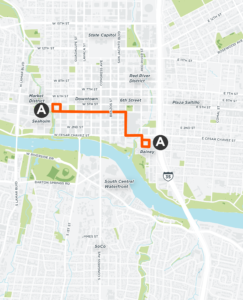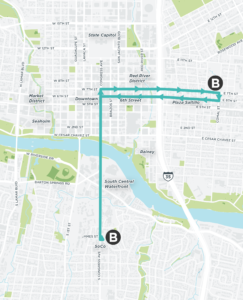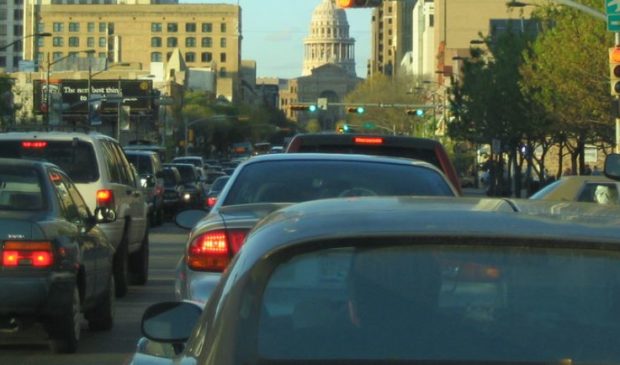DAA study seeks community feedback for proposed downtown transit routes
Wednesday, December 9, 2020 by
Jackson Barton The Downtown Austin Alliance is looking for resident and visitor feedback on two proposed transit routes it hopes will make traveling between different parts of downtown faster and more convenient.
The proposed downtown circulator routes, which would serve downtown, South Congress and some of East Austin, are open to public feedback on the DAA’s online survey through Dec. 11. The DAA hopes to launch a pilot of the chosen route by 2021.
Route A runs between the Market District and Rainey Street, primarily traveling along Fourth Street. Route B runs from James Street along South Congress Avenue to Plaza Saltillo east of Interstate 35.

Proposed Route A runs between the Market District and Rainey Street. (Image by Downtown Austin Alliance)
DAA spokesperson Casey Burack said in a press release that the two routes, the result of information gleaned from the alliance’s Circulator Study, would be sustainable and safe mobility options that aid post-Covid-19 economic recovery.
Burack said the survey intention is to find out whether people would use the circulator route as “things get back to normal and people are commuting more and more back to downtown, or they’re feeling more comfortable and safe coming back to downtown because Covid is on its way out.”
Burack said a short-term alternative transit option would be provided while the Capital Metropolitan Transportation Authority’s Project Connect comes online and Interstate 35 is redeveloped over the next decade.
The DAA may not be able to pay for the entire project on its own, Burack said in an email to the Austin Monitor, and is looking for partners to help fully fund the project’s future pilot.
The DAA based the two proposed routes on Bluetooth data collected from car, scooter and public transit users. About 62 percent of downtown traffic comes from visitors to Austin, Burack said, adding that there are few public transit options downtown.

Proposed Route B runs from James Street along South Congress Avenue to Plaza Saltillo. (Image by Downtown Austin Alliance)
“There is a transit gap going east-west across downtown, and really at the heart of downtown,” Burack said. “While there are scooters and trips more commonly taken by an Uber or Lyft … there could be a much more efficient way to move people around.”
The DAA prefers that the future downtown transit route be free for riders, but is waiting to see what the report recommends. The final report, including highlights of the community feedback on the two proposed routes, will be published in December.
Burack said the DAA has not decided on the type of vehicle for the proposed circulator route, but has already talked with city officials about priority turn lanes and other anti-congestion traffic mechanisms in case it opts for buses. The alliance is aiming for a maximum of 15 minutes between pickups along the final route.
Austin’s first free dedicated downtown shuttle, the ’Dillo, debuted in 1984 and disappeared in 2009 amid the economic recession and a lack of ridership. The DAA used the iconic green trolleys as a case study in its report.
Project Connect and Capital Metro have been providing advice to coordinate with the DAA during the circulator study. Jacob Calhoun, Project Connect project manager, said the goal is for the two different routes and projects to complement each other.
“With Project Connect, it’s usually high-capacity transit lines,” Calhoun said. “Those typically allow people to cover longer distances quicker and more frequently than they would otherwise, whereas a circulator is much more concentrated to a specific geographic area.”
Photo made available through a Creative Commons license.
This story was written by a journalism student at the University of Texas at Austin. The Austin Monitor is working in partnership with the UT School of Journalism to teach and publish stories produced by students in the City and County Government Reporting course.
The Austin Monitor’s work is made possible by donations from the community. Though our reporting covers donors from time to time, we are careful to keep business and editorial efforts separate while maintaining transparency. A complete list of donors is available here, and our code of ethics is explained here.
You're a community leader
And we’re honored you look to us for serious, in-depth news. You know a strong community needs local and dedicated watchdog reporting. We’re here for you and that won’t change. Now will you take the powerful next step and support our nonprofit news organization?













